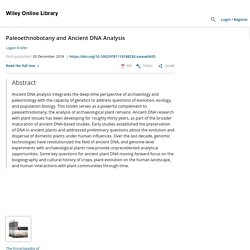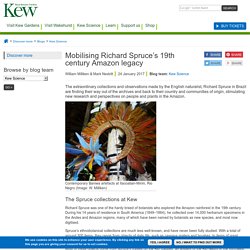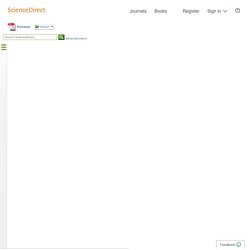

Paleoethnobotany and Ancient DNA Analysis - Kistler - - Major Reference Works. Ancient DNA analysis integrates the deep‐time perspective of archaeology and paleontology with the capacity of genetics to address questions of evolution, ecology, and population biology.

This toolkit serves as a powerful complement to paleoethnobotany, the analysis of archaeological plant remains. Ancient DNA research with plant tissues has been developing for roughly thirty years, as part of the broader maturation of ancient DNA‐based studies. Early studies established the preservation of DNA in ancient plants and addressed preliminary questions about the evolution and dispersal of domestic plants under human influences. Over the last decade, genomic technologies have revolutionized the field of ancient DNA, and genome‐level experiments with archaeological plants now provide unprecedented analytical opportunities. Mobilising Richard Spruce’s 19th century Amazon legacy. Contemporary Baniwa artefacts at Itacoatiari-Mirim, Rio Negro (Image: W.

Milliken) The Spruce collections at Kew Richard Spruce was one of the hardy breed of botanists who explored the Amazon rainforest in the 19th century. During his 14 years of residence in South America (1849–1864), he collected over 14,000 herbarium specimens in the Andes and Amazon regions, many of which have been named by botanists as new species, and most now digitised. Spruce’s ethnobotanical collections are much less well-known, and have never been fully studied.
Most of these objects come from Spruce’s travels on the Rio Uaupés, an affluent of the Rio Negro in the northwest part of the Amazon. Dagoberto Azevedo (Tukano) at JBRJ with Banisteriopsis caapi (ayahuasca), a culturally important plant in the upper Amazon (Image: M. Rethinking museum collections In summer 2016 we hosted two researchers from the Rio de Janeiro Botanical Garden (JBRJ), a key partner in the project. Herbarium exhibits plant species significant to Hmong people. Herbarium in Kerala for Tudi tribe. Traditional medicine and cosmetics in Mozambique. MIER Journal of Educational Studies, Trends and Practices. Comparison of Herbarium Label Data and Published Medicinal Use: Herbaria as an Underutilized Source of Ethnobotanical. Our study shows that the modern (1900–2010) herbarium specimens we surveyed comprise a significant source of data.

They are information-rich, often describe how the plant is used, and overall, the information they contain appears broadly similar to the information recorded in the literature. We were surprised at how frequently specimens contained information about the specific applications of the plants used; we expected that many specimens might simply report that a species was used medicinally. Traditional Medicine. Drug Discovery. A Lancaster Environment Centre, Lancaster University, Bailrigg, Lancaster LA1 4YQ, United Kingdomb West Virginia University, Office: Brooks Hall 145, 98 Beechurst Ave., Morgantown, WV 26506-6300, United States Received 8 May 2014, Revised 27 August 2015, Accepted 1 September 2015, Available online 5 September 2015 Choose an option to locate/access this article: Check if you have access through your login credentials or your institution Check access doi:10.1016/j.geoforum.2015.09.001 Get rights and content Highlights Critical historical analysis of bioprospecting and biodiversity offsetting.

A less studied output of bioprospecting are mass botanical herbarium collections. We trace the bioprospecting collections now digitized for biodiversity offsetting metrics. We examine labour in re-mining bioprospecting biodata for market legibility. Scientific institutions develop unevenly under market-based conservation. Abstract Madagascar has always held a special place on the bioprospecting map.
Keywords. Medicinal plant uses and names from the herbarium of Francesc Bolòs (1773–1844) Ethnopharmacological relevance Ethnobotany takes into account past uses to be projected into the present and future.

Most current ethnobotanical research is focused, especially in industrialised countries, on obtaining information of plant uses from elderly people. Historical ethnobotany is less cultivated, although papers have demonstrated its interest. Particularly poor, but potentially very relevant, is the attention paid to historical herbaria as a source of data on useful plants. Aims of the study Bearing this in mind, we studied the herbarium of the Catalan pharmacist and naturalist Francesc Bolòs (1773–1844), which contains information on medicinal uses and folk names, with the aim of establishing a catalogue of plants and uses and tracing them through old and contemporary literature.
Methodology The ca. 6,000 plant specimens of this herbarium were investigated to assess those including plant uses and names. Uses of Specimens in Ethnobotany.